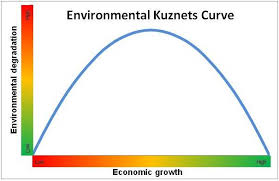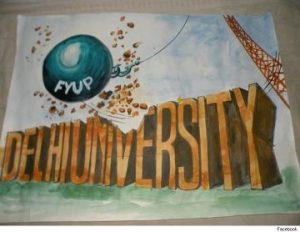Kuznets curve graphs the hypothesis that as an economy develops market forces first increases and then decreases inequality. Nobel prize winner Simon Kuznets was the first one who advanced the hypothesis in 1950s and 1960s. Kuznets curve shows that as the nation undergoes industralization there is a migration of rural people to urban places. Since more industralization means more labour required and hence rural population looking for better wages, they shift to urban areas and causes rural-urban inequality. First the inequality increases and then it is expected to decrease when a certain level of average income is reached. Kuznets curve follows an inverted ‘U’ shape. In 1991 Grossman and Krusser established the Environmental Kuznets curve and that became a standard feature of environmental policy.
Environmental Kuznets curve is a relationship between various indicators of environmental degradtion and income per capita. It follows an inverted ‘U’ shape, as in earlier stages with the increase in pollution there is economic degradation but after a particular level of income per capita the trend reverses ie high income level economies growth leads to environmental improvement. In most of the rapidly growing countries with increase in pollution there is degradation, and in wealthy economies growth is slower and pollution reduction efforts can overcome. So the only way to attain a decent environment condition is to become a rich nation.
If we talk about Envirnomental Kuznets curve relation for country like India , India is one of the fastest developing economy and therefore the nation is facing a very tough trade off between economic growth and environmental protection. In India damage caused by pollution is estimated to cost $14 billion annually which is around 4.5% to 6% of GDP (Economic Survey of India; 1998-1999). To resolve the environmental degradation, Governman of India has initiated many environmental policies from late 1970s , Enviromental Kuznets curve hypothesis has helped to realise that India needs to improve technologies and policies that helps to reduce environmental degradation.





17 Comments. Leave new
well said Prachi, a truely well studied article.
But,
Does environmental degradation relies on Urbanization and Industrialization only?? I think other factors are also playing an important role like Population growth, lack of awareness, neglegence and a mind-set of people…?? isn’t it?
Quite informative!
Hie Abhishek, u said it very rightly, these factors are of major concern specially the increasing population and india is a developing country so such degradation is unavoidable but still government has tried to implement such policies but they aren’t much effective yet. Also swach bharat abhiyan is an important step towards this but many of us being aware of it still not following it.
Hii Prachi….
Actually Govt. of India have policies on paper but the funds required to impliment those policies is the biggest worry!
Indian people and Govt. dont want to spend a bit on such policies-implimentation.
But this also will change….
It takes time to change such things ….. We still can have hope for better India!
Very nice work.!!
Informative.
informative!
This argument contributes to the current complaints from the NGT
I wish we reach the down-hill part of Kuznets curve soon! Good work.
informative article…
Well written!
Nice information
Informative
Welllll…its very NYC.
well written, Prachi!
Nice and informative.
Youre so cool! I dont suppose Ive learn something like this before. So nice to find any person with some authentic ideas on this subject. realy thank you for beginning this up. this web site is something that is needed on the net, someone with slightly originality. useful job for bringing something new to the internet!